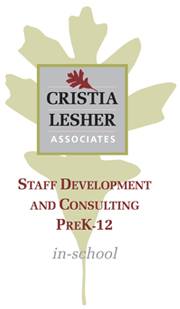Helping Middle Schoolers Discover Their Inner Mathematician: Using concrete and pictorial modeling to understand and implement the Common Core
Available as a Summer Institute by Tom Schersten
 Location: This new three-to-five day Summer Math Institute is available to come to your district.
Location: This new three-to-five day Summer Math Institute is available to come to your district.
Audience: Grades 6-8 teachers, administrators, and paras; general and special education
Institute Leader: Tom Schersten has a gift for helping educators become comfortable and confident teaching the Common Core for Math. He succeeds with teachers who love math as well as those who might even hate it. He does this with the rigor of a mathematician, the gentleness of a kindergarten teacher, and the high expectations of the CCSS. Tom says, “We can combine high standards with ‘humane’ math instruction. We have to remember, not everyone learns math the same way. We’ve created a nation of math phobics by failing to respond to that simple truth. My aim is to help teachers right that wrong, for the sake of all our children.” Tom taught in K-8 classrooms for 20 years, with 8 years in grades 6-8, including 3 years of 8th grade algebra.
A word about base ten blocks, pattern blocks, and the Common Core: The CCSS expects students to demonstrate their understanding through math modeling. Base ten blocks and pattern blocks are perfect tools for this. Their generous use invites many more learners into math than traditional teaching methods ever could. Learn how to use them to differentiate math instruction in a lively and deeply effective way for middle school math students.
CONTENT: Tom will guide participants in the use of hands-on manipulatives to model the mathematics of Middle School with its new Common Core demands for arithmetic, algebraic, geometric, and statistical thinking.
This is how participants will spend their time during this exciting three-to-five day training:
- Demystifying the CCSS for your grade and making it your own.
Teachers will catapult their understanding of CCSS expectations to new levels. This will be done through comprehension exercises designed both for teachers who feel they grasp math easily as well as those who don’t. Participants will have the distinct pleasure of experiencing what it feels like to have math taught to them the way they learn best. - Understanding Common Core Math Content so well that you can teach math understanding, not just procedures.
The Standards expect students to be able to explain the reasoning behind procedures that most teachers learned only by rote, such as inverting and multiplying when dividing by a fraction. In short, teachers must teach things they’ve never learned. This Institute is designed to rectify that with exciting differentiated teaching for the participants themselves.Participants will put their hands on base ten blocks and pattern blocks in order to UNDERSTAND the math in the Critical Areas of the Common Core that are selected for this training. (See Tailoring This Institute for Your Teachers, below.) Emphasis will be on arithmetic, algebraic, geometric, and statistical thinking.Then participants will learn how to use these same manipulatives to dynamically teach their students to understand the math for themselves. - Learning how to use Common Core Math Practices to better teach math to all your students.
Use of manipulatives such as base ten blocks and pattern blocks is a powerful form of math modeling for Grades 6-8 learners. Modeling is a math practice expected in the Common Core.Participants will learn how to use math modeling, questioning strategies, and differentiated instruction to effectively teach every one of their students. - Experiencing sample lessons you can replicate back in your classroom in the fall.
Tom will demonstrate exciting math lessons that captivate middle school minds. These lessons can be immediately replicated back in the classroom, with an emphasis on questioning strategies for leading the classroom conversation and for differentiating the instruction.Teachers will feel ready for math instruction in the fall in a whole new way!
TAILORING THIS INSTITUTE TO YOUR TEACHERS: Institutes of three-to-five days are designed specifically for the requesting school or district in terms of the grade levels involved, the number of days encumbered, and the specific standards focused on during the week, many of which will be related to the Critical Areas of the Common Core at each grade level.
Here are Tom’s condensations of the Critical Areas identified for grades 6-8:
Grade 6
- connecting ratio and rate to whole number multiplication and division, using concepts of ratio and rate to solve problems, and connecting ratios and fractions
- completing understanding of fractions, including why inverting and multiplying makes sense, extending the notion of number to the system of rational numbers, which includes negative numbers, and reasoning about the location of points in all four quadrants of the coordinate plane
- understanding the use of variables, writing, interpreting, and using expressions and 1-step equations to solve problems, and using equations to describe relationships between quantities
- developing an understanding of statistical thinking: understanding the meanings of measures of central tendency and variability and describing and summarizing numerical data sets, identifying clusters, peaks, gaps, and symmetry
Grade 7
- developing understanding of and applying proportional relationships to solve multi-step problems, including in the contexts of percent and scale drawings, graphing proportional relationships, and understanding slope as the unit rate
- developing a unified understanding of number, using properties of operations and the relationships between operations to explain and interpret the rules for operations with negative numbers, and formulating expressions and equations to solve problems
- solving problems involving the circumference and area of a circle and involving area, surface area, and volume of two- and three-dimensional objects composed of triangles, quadrilaterals, polygons, cubes and right prisms and gaining familiarity with angle measurement and informal geometric constructions
- comparing two data distributions to address differences between populations and to begin informal work with random sampling to generate data sets
Grade 8
- using linear equations and systems of equations to represent, analyze, and solve problems, including using a linear equation to describe the association between two quantities in bivariate data, interpreting slope and y-intercept in terms of the context, and solve systems of two linear equations in two variables and relate the systems to pairs of lines that intersect, are parallel, or are the same line
- grasping the concept of function as a rule that assigns to each input exactly one output, representing functions in tabular and graphic form, and describing how aspects of the function are reflected in the different representations
- analyzing two- and three-dimensional space and solving problems using ideas about distance and angles and how they behave under translations, rotations, reflections, and dilations, showing that the sum of the angles of a triangle make a straight line, understanding the relationships among the angles created when a transversal cuts parallel lines, understanding, proving, and applying the Pythagorean theorem, and solving problems involving the volume of cones, cylinders, and spheres

